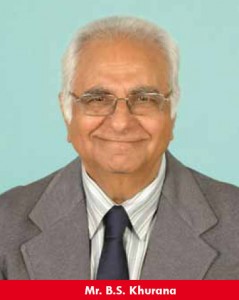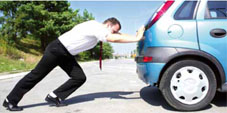By B.S. Khurana, Road Safety Practitioner: METASAFE – Driving Safety Sense
 The World Health Organization and the United Nations recognize road deaths as a “killer disease” and a major health issue of modern times. Seventeen deaths an hour on Indian roads! This is not acceptable in any civilized society. Every life we lose counts – bread-winners, pedestrians, cyclists, school children, at greater risk than ever before. All stake-holders have a moral responsibility to make roads safer. Man, machine, road, industry, State and society – a lethal combination of these elements, not disregarding inferior or counterfeit parts. The homicidal capacity increases with the power and tonnage of the vehicles. The line between “death and life” is becoming thinner by the hour.
The World Health Organization and the United Nations recognize road deaths as a “killer disease” and a major health issue of modern times. Seventeen deaths an hour on Indian roads! This is not acceptable in any civilized society. Every life we lose counts – bread-winners, pedestrians, cyclists, school children, at greater risk than ever before. All stake-holders have a moral responsibility to make roads safer. Man, machine, road, industry, State and society – a lethal combination of these elements, not disregarding inferior or counterfeit parts. The homicidal capacity increases with the power and tonnage of the vehicles. The line between “death and life” is becoming thinner by the hour.
“Remember, upon the conduct of each depends the fate of all” – Alexander the Great.
Death trap
Yet we have the ubiquitous dealer who makes or distributes spurious or duplicate goods. An expert who creates death traps! His products spell danger, conducts his clients to the chamber of horror. There are fine drivers and finer automobiles, yet somewhere lurks the fear of a hidden part or component that could bring disaster without a second’s notice. For example, critical components like brake parts which contribute directly to road safety or friction surfaces much maligned and abused, which actually stop the vehicle, have the dice loaded against them. Any deficiency can mushroom to zero braking when needed most. Most drivers are unaware of the potential danger. Lives of millions depend upon braking efficiency.
Constant quest for higher speed, modern trends in vehicle design, high torque engines and growing traffic hazards should make manufacturers worth their salt to remain aware of quality and reliability. Safety items like brakes are selected after many months of destructive testing on computerized rigs and dynamometers, equivalent of thousands of miles of gruelling work. Brake temperatures can rise to 300-350 degree C when braking down a hill. Inferior materials break down resulting in abnormal fade, high wear and inability to provide the required braking power. There are no short cuts to quality!
Price tag
That spurious materials in the guise of “genuine” brands are flooding the market is a serious matter – the unscrupulous working hand-in-glove with dubious dealers behind a mask of respectability. The unwitting user falls a prey to the attractive price tag without realizing the consequences. The dealer is willing to make a quick buck with scant regard to safety. Imagine taking chances with inferior or spurious materials, pure and simple suicide!
 Initially easy to disguise reduction in quality that this entails as the outward appearance is much the same. Eventually cheap parts can be exposed only by cutting and analyzing them that their cosmetic worth is revealed. They fall apart extremely quickly and often barely cope with the situation for which they were intended.
Initially easy to disguise reduction in quality that this entails as the outward appearance is much the same. Eventually cheap parts can be exposed only by cutting and analyzing them that their cosmetic worth is revealed. They fall apart extremely quickly and often barely cope with the situation for which they were intended.
So, pulling in one direction in the market is extreme price consciousness and pulling in the other direction is the need to maintain quality and high level of service that should go with it. The discerning customer should know the fact from fiction!
Deadly risk
Nobody gets too concerned about counterfeiting T-shirts and blue jeans with brand logos. But safety-related automotive parts are no laughing matter!
What is counterfeiting? Basically, it is a broad term that covers any form of deception designed to trick end users into believing the parts they purchased are produced by an OEM or a reputable and reliable after-market manufacturer. The key to deception lies in the fact that the counterfeit part or packaging closely resembles the real thing. No attempt is made to identify its source of manufacture.
The three general rules to guard against being fooled into buying counterfeit parts:
* Know your after-market supplier. As a regular and loyal customer, chances are he would not knowingly sell you counterfeit parts.
* Do not shop by price alone, unless you have a way of evaluating it before buying. Looks and packaging can be completely deceptive. It is intended to be that way; parts look as good as and sometimes even better than a well-known name. It is what is on the inside that really counts. Counterfeiters count on your weakness for the price tag and not taking the precaution of adherence to rigid specification of known and reliable after-market manufacturers.
Suggestions
* Firstly, the manufacturer must maintain his reputation of putting “quality and safety” first and guard the end-user in turn, irrespective of what he procures from market or service station. OEM and brand sector should intensify garage contacts and warn the users of ills of counterfeit parts.
* A parts dealer is no longer merely a merchant trading his wares. He has professional status and importance. He will be respected if he shows utmost sincerity, skill and guidance in identifying completely with customers’ best interests. A manufacturer’s reputation depends on how the dealers and distributors conduct themselves to create satisfied and grateful clients.
* Motor parts dealers associations could frame a code of “business ethics’ [prominently displayed] to say that the members shall refrain from stocking or selling spurious parts. Any member violating it may be suitably penalized.
* Awareness need be created against use of spurious/counterfeit parts fraught with risk and publicity posters, in local language, displayed in every town, and through cinema slides. Consumer protection societies, industry chambers and OEMs could be involved in campaigns to discourage entry of doubtful materials and tracking down the culprits. Once identified, such middlemen or suppliers are reported by the associations for expeditious legal action. Media is encouraged to do investigating reporting and expose the culprits.
Minimum norms for testing equipment ought to be laid down for critical items. Independent organizations should carry out spot checks. Dealers associations can draw samples voluntarily; this will create a sense of alertness.
* Motor owners’ clubs be encouraged in small towns, a warn-the-motorist campaign be launched by the organized sector, regional transport authorities, traffic police and social organizations.
* Society must condemn those indulging in manufacture and sale of counterfeits endangering safety, and the State and the industry together must deal with this social evil with a heavy hand.
“Accidents don’t happen, they are made” – Earnest Greenwood
